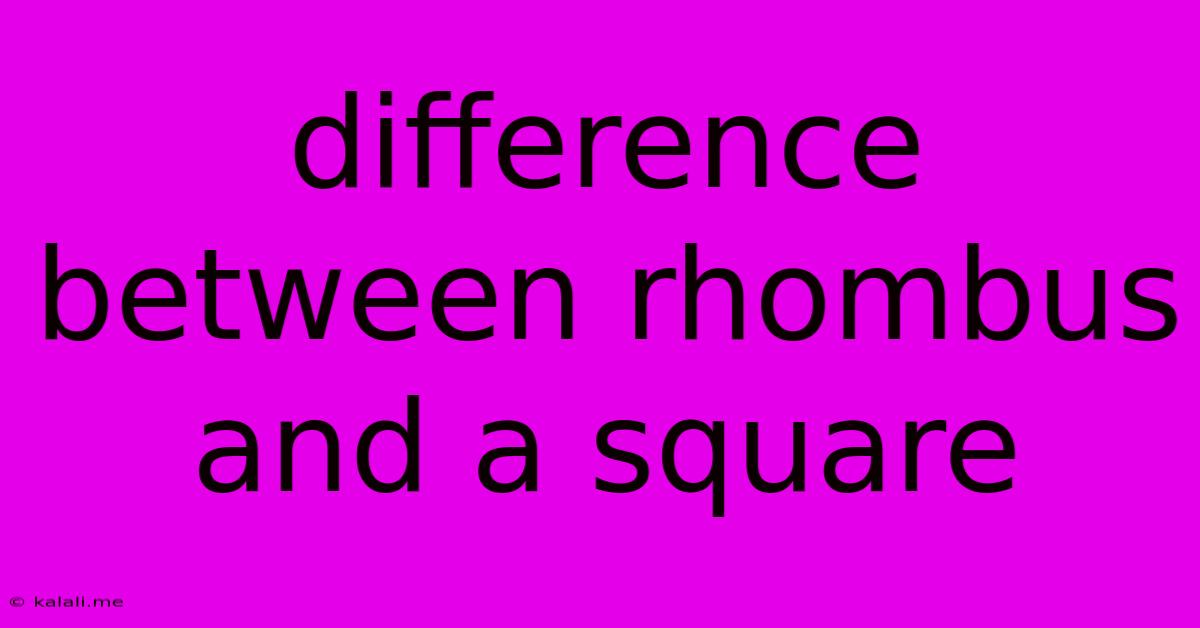Difference Between Rhombus And A Square
Kalali
Jun 13, 2025 · 3 min read

Table of Contents
Rhombus vs. Square: Unveiling the Subtle Differences
This article delves into the fascinating world of quadrilaterals, specifically comparing and contrasting two seemingly similar shapes: the rhombus and the square. While both possess four sides, their defining characteristics set them apart. Understanding these differences is crucial for anyone studying geometry or working with shapes in various fields. By the end, you'll be able to confidently distinguish a rhombus from a square and understand their unique properties.
Defining Characteristics: Rhombus
A rhombus is a quadrilateral with all four sides equal in length. This is its primary defining feature. However, its angles are not necessarily equal. Think of it as a "squashed" square; it maintains the equal side length but loses the right angles. Key properties of a rhombus include:
- Equal side lengths: This is the fundamental characteristic.
- Opposite angles are equal: The angles opposite each other are congruent.
- Adjacent angles are supplementary: This means that the sum of adjacent angles is 180 degrees.
- Diagonals bisect each other at right angles: The diagonals intersect each other perpendicularly, dividing each other into equal halves.
- Diagonals bisect the angles: Each diagonal divides the angles it passes through into two equal angles.
Defining Characteristics: Square
A square, on the other hand, is a more specialized quadrilateral. It inherits all the properties of a rhombus but adds an extra crucial characteristic: all its angles are right angles (90 degrees). This makes it a very regular and symmetrical shape. Key properties of a square include:
- Equal side lengths: Just like a rhombus.
- Four right angles (90 degrees): This is what distinguishes it from a rhombus.
- Opposite sides are parallel: This is a property shared with both squares and rhombuses.
- Diagonals are equal in length: Unlike a rhombus, where diagonals can be of different lengths, a square's diagonals are equal.
- Diagonals bisect each other at right angles: Similar to a rhombus.
The Venn Diagram of Understanding
Think of it this way: all squares are rhombuses, but not all rhombuses are squares. A square is a special case of a rhombus – a rhombus with the added constraint of having right angles. You could visualize this relationship using a Venn diagram; the set of squares would be entirely contained within the set of rhombuses.
Real-World Examples
Understanding the difference between rhombuses and squares has practical applications. You might encounter rhombuses in:
- Crystals: Certain crystal structures exhibit rhombic shapes.
- Tessellations: Rhombuses can be used to create interesting and aesthetically pleasing patterns.
- Kites: Some kite designs utilize rhombic shapes.
Squares, on the other hand, are incredibly common in:
- Buildings: From windows to tiles, squares are ubiquitous in architecture.
- Games: Chessboards, game boards, and many other games utilize square grids.
- Everyday objects: Many everyday items, such as boxes and paper, are square or rectangular (a type of parallelogram related to squares and rhombuses).
Conclusion
In summary, while both rhombuses and squares are quadrilaterals with four equal sides, the presence of four right angles differentiates a square from a rhombus. A square is a more specific type of rhombus, inheriting all its properties while adding the constraint of right angles. Understanding these distinctions is vital for grasping fundamental geometrical concepts and applying them to real-world scenarios.
Latest Posts
Latest Posts
-
Which Of The Following Is An Automatic Stabilizer
Jun 14, 2025
-
What Belief Drove The Creation Of The International Monetary Fund
Jun 14, 2025
-
How To Send Sat Score To College
Jun 14, 2025
-
Four Bells Toll Together At 9am
Jun 14, 2025
-
Identify A True Statement About Theories
Jun 14, 2025
Related Post
Thank you for visiting our website which covers about Difference Between Rhombus And A Square . We hope the information provided has been useful to you. Feel free to contact us if you have any questions or need further assistance. See you next time and don't miss to bookmark.